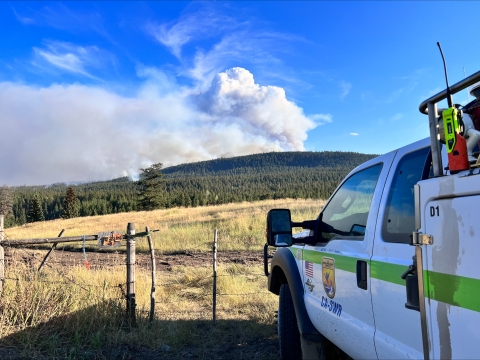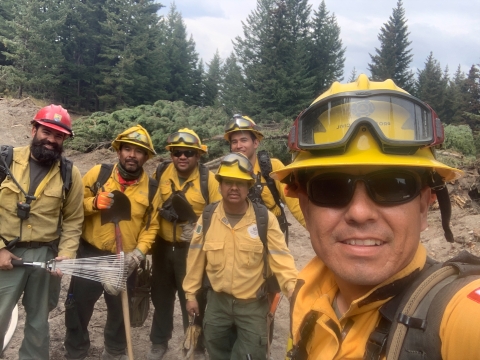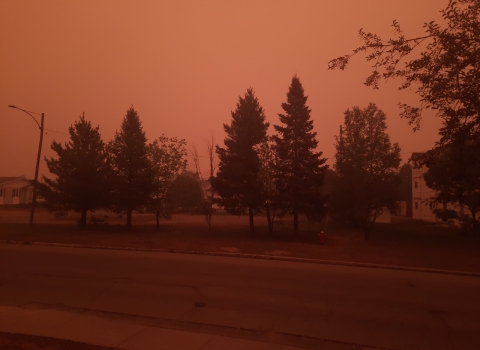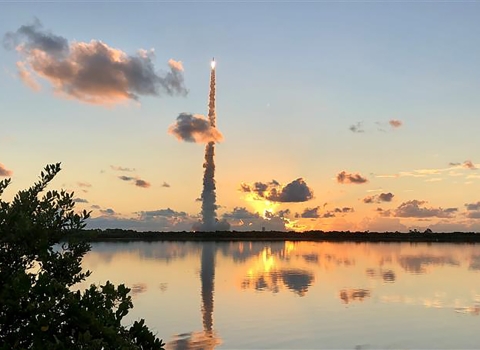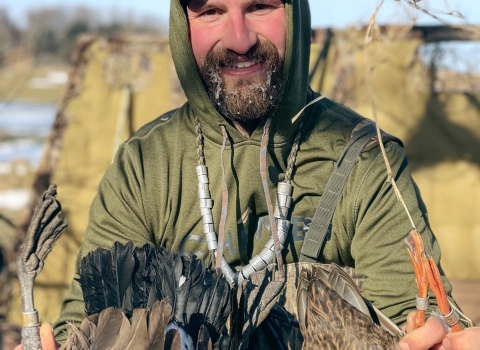When major wildfire incidents occur, resources from across the country (and sometimes from other countries) are requested to assist with firefighting efforts. Earlier this year, Canada experienced a wildfire season big enough to request assistance from countries across the world. U.S. firefighting resources and thousands of personnel were sent to Canada for a period of several months to assist with their unprecedented wildfire season.
Among those resources was a U.S. Fish and Wildlife Service wildland fire engine staffed by Engine Captain Agustin (Jaime) Rodriguez, Fire Engine Operator Chris Fenske and seasonal firefighter Ignacio Velazquez. This small engine crew helped to form an engine strike team with other wildland fire engines from the USDA Forest Service and Bureau of Land Management.
An engine strike team consists of five of the same type of engines that come together to assist with fire suppression in rugged terrain.
Engine teams from the three agencies responded together to the Adams Lake Fire. On the first day of their assignment, Rodriguez, Fenske and Velazquez spent the day becoming familiar with the situation, geography and expectations of the fire situation.
“When we first arrived, there was a learning period where the Canadian fire crews had to learn to trust in our ability to fight fire to their standard,” remembers Fenske. “When we showed up, we realized our wildland fire equipment was much more contemporary than what they were using. The unfamiliarity with our equipment and tactics highlighted the need to proactively establish trust between firefighting resources.”
Once that trust was established, however, the engine strike team became highly sought after. Soon, the three USFWS firefighters found their firefighting services in demand and were frequently requested on all parts of the fire.
“Once we were fully operational, it was so intriguing to learn the differences in our firefighting tactics and theirs,” said Rodriguez.
Rodriguez describes the differences in method are typically due to the number of firefighters available and the type and condition of vegetation fueling the fire.
Throughout their assignment in Canada, the team worked with other countries who also sent firefighting resources to assist in the suppression efforts. Because Rodriguez speaks multiple languages, the USFWS fire crew was paired with one of the Mexican crews and one of the Brazilian crews. His ability to communicate with both crews helped work through assignments and suppression operations.
“Working with three different countries while in a foreign country yourself is a once in a lifetime experience,” said Rodriguez. “These experiences are something I’ll carry with me for the rest of my life. There is so much we can learn from each other to continue to improve our firefighting tactics.”
Another U.S. Fish and Wildlife Service firefighter, from the Southern California Fire Zone, Matthew Pecos, assisted on a separate crew, serving as a task force leader with about 40 firefighters from Brazil.
Pecos built a strong relationship with the Brazilian crews and became familiar with their firefighting tactics to accomplish their mission.
“I was expecting to do a lot more task explanation,” said Pecos, “but I quickly realized we had a lot in common when it came to suppression activities and tactics. Crewmembers were especially experienced in working in thick, unforgiving terrain as much of their suppression work occurs in the Amazon.”
One of the more common tools to firefighting is the chainsaw. Firefighters use chainsaws to fell trees, cut snags, clear fireline, and reduce overall fuel for a fire to burn. Brazilian crews, however, do not use chainsaws and instead have mastered the use of machetes to control thick vegetation.
“I’m still in awe at how effective it was at cutting back fuel,” Pecos said when describing the machete technique.
Before final goodbyes, Pecos exchanged hugs and handshakes and offered up U.S. Fish and Wildlife Service patches and pins for the Brazilians to take home.
“It’s pretty cool to think about our agency logo being added to a firefighter’s patch or pin collection as far away as Brazil,” said Pecos. “That’s something you don’t get the opportunity to contribute to often.”
The USFWS teams have returned with new appreciation for techniques and tools of the international firefighting community.
